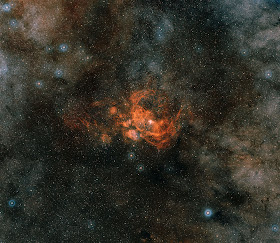 |
| A nebula, the Pillars of Creation |
The term used to refer to any astronomical object outside of the Milky way, including galaxies. The Andromeda Galaxy, for example, was called the Andromeda Nebula before galaxies were discovered by Edwin Hubble based on his observations from 1922 to 1923. He published his findings on November 23, 1924 in The New York Times.
Now, nebulas strictly refers to gas and dust clouds and not for groups of stars.
One of the most outstanding and memorable image of a nebula is the "Pillars of Creation". It is a region of gas, dust, and other materials that grouped together to form larger masses, These attract further matter, and eventually will become massive enough to form stars. The remaining materials are then believed to form planets, and other planetary system objects.
VLT Takes a Close Look at the War and Peace Nebula
Deep in the Milky Way in the constellation of Scorpius (The Scorpion) lies the War and Peace Nebula, or NGC 6357 [1], a region of space where new stars are being born in of chaotic clouds of gas and dust [2]. The outer parts of this vast nebula have now been imaged by ESO’s Very Large Telescope, producing the best picture of this region taken so far [3].
The new picture shows a broad river of dust across the centre that absorbs the light from more distant objects. To the right there is a small cluster of brilliant blue-white young stars that have formed from the gas. These are probably only a few million years old, very young by stellar standards. The intense ultraviolet radiation streaming out from these stars is hollowing out a cavity in the surrounding gas and dust and sculpting it in strange ways.
Video: The War and Peace Nebula
The whole image is covered with dark trails of cosmic dust, but some of the most fascinating dark features appear at the lower right and on the right hand edge of the picture. Here the radiation from the bright young stars has created curious elephant trunk columns, similar to the famous “pillars of creation” in the Eagle Nebula. Cosmic dust is much finer than the more familiar domestic variety. It more closely resembles smoke and consists mostly of tiny particles of silicates, graphite, and water ice that were produced and expelled into space by earlier generations of stars.
The bright central part of NGC 6357 contains a cluster of high-mass stars whose inhabitants are among the brightest in our galaxy. This inner region, not seen in this new picture, has been much studied and imaged by the NASA/ESA Hubble Space Telescope. But this new picture shows that even the less well known outer parts of this nursery contain fascinating structures that can be revealed by the power of the VLT.
These images were produced as part of the ESO Cosmic Gems programme [4].
Notes
[1] The curious name, which has no link to Tolstoy’s great novel, was given to this object by scientists working on the Midcourse Space Experiment. They noted that the bright, western part of the nebula resembled a dove, while the eastern part looked like a skull in their infrared images. Unfortunately this effect cannot be seen in the visible-light image presented here. The object is also occasionally nicknamed the Lobster Nebula.
[2] NGC 6357 was first recorded visually by John Herschel from South Africa in 1837. He only recorded the brightest central parts and the full scale of this huge nebula was only seen in photographs much later.
[3] The part of NGC 6357 shown in the new VLT image has not been targeted by the NASA/ESA Hubble Space Telescope.
[4] The ESO Cosmic Gems programme is an outreach initiative to produce images of interesting, intriguing or visually attractive objects using ESO telescopes, for the purposes of education and public outreach. The programme makes use of small amounts of observing time, combined with otherwise unused time on the telescopes’ schedules so as to minimise the impact on science observations. All data collected may also be suitable for scientific purposes, and are made available to astronomers through ESO’s science archive.
RELATED LINKS
European Southern Observatory
ESO - Very Large Telescope
National Aeronautics and Space Administration (NASA)
European Space Agency
Hubble Space Telescope Images 'Colliding' Galaxies
Atacama Large Millimeter Array (ALMA) Provides Clear Picture of Radio Galaxy Centaurus A (NGC 5128)
New Image of NGC 5128 Centaurus A From The ESO Gives Deepest View
VISTA Telescope Captures Globular Cluster Messier 55 In Rich Detail
The Reflection Nova Messier 78 and the Atacama Pathfinder Experiment telescope (APEX)
NGC 6604 Star Cluster Surrounded by Gas and Dust Clouds

